How important is the display to you when choosing a device? Still in doubt? In this article we will look at the two main types of displays that are found on the market today mobile devices, we’ll look at their features, and most importantly, we’ll help you decide which display is best for you.
LCD displays
Let's start with, perhaps, the most popular LCD matrix. LCD translated from English means “liquid crystal display”, but in common people it is usually called simply “elseed”. The first color LCD display was introduced by Sharp in 1987, and over time they began to displace CRT (cathode ray tube) monitors.
Using a TN matrix as an example, let's look at the operating principle of this display. An LCD display consists of pixels, in turn, pixels consist of subpixels, which represent 3 colors - red, green, blue, which add up to white. Do an experiment: take colored cardboard, cut out a circle with three colors (green, red, blue) and try to quickly scroll through it, you will notice that instead of three colors you get one - white. With just three colors you can create a huge variety of shades, with 16 million shades being optimal. There is no point in doing more; it will directly affect the memory, which mobile devices always lack. Moreover, the human eye recognizes at most 10 million colors. Each subpixel consists of: a color filter that determines the color of the subpixel (red, green, blue), horizontal and vertical filters, transparent electrodes, and liquid crystal molecules. Depending on what technology is used (TN, IPS), the principle of interaction between the crystal and the electrodes will be determined.
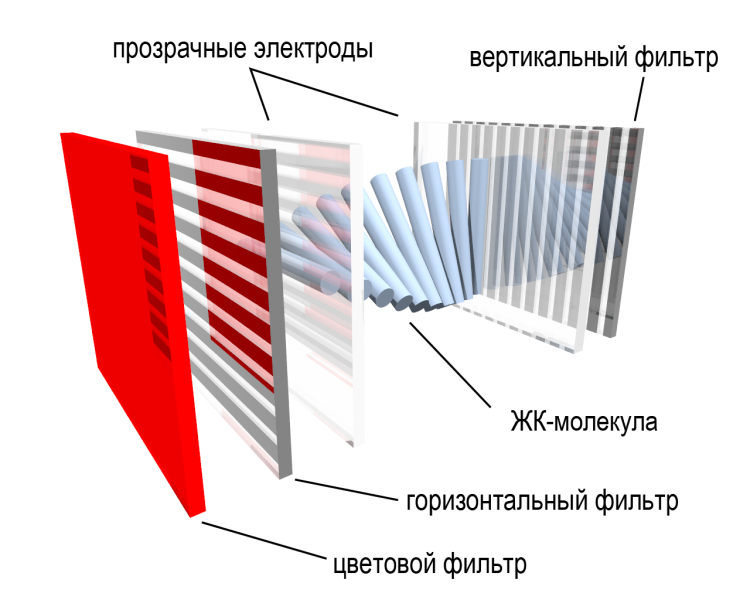
It is known from a physics course that light polarized on the surface of a body in a certain plane can pass through another surface only if it is in the same plane as the first. For example, light passes through a diffraction grating and is polarized along a vertical plane; if the next surface is in a plane located at 90 degrees relative to the first, then the light will not pass through the second surface, but if at 45 degrees, then the light will pass only half. But why do we need LCD molecules? They play a key role: the crystal determines how much light will pass through the color filter; it directs the light into the same plane as the surface of the second filter.
In TN matrices, the electrodes are located in the same way as the filters, and they direct our crystal into the plane of the second filter, which leads to the free passage of light through the diffraction grating. If we apply voltage to the transistors, then the crystal molecules are formed in a row, and depending on the strength of the voltage, we can regulate how many crystal molecules will be ordered perpendicular to the second filter. In other words, the more voltage the transistor gives us, the less light our subpixel will let through. Therefore, when pixels burn out in TN matrices, they are white, not black, since burnout implies the failure of the transistor, which can no longer supply current and regulate the transmittance of light, accordingly, our light passes through the color filter without problems .
You're probably wondering: "Why defective pixels They also come in black"? It's all about technology: dead black pixels are found in IPS matrices, since in such matrices, when voltage is applied, the crystal conducts light in the same plane as the filter. Moreover, in IPS matrices, since in a quiet state the crystals do not pass through the filter and, accordingly, light also does not pass through, we observe a deep black color.
I would also like to mention artificial lighting. Unlike AMOLED displays, LCD pixels are unable to emit light. They are helped in this by the backlight, which also affects the brightness of the display itself.
AMOLED displays
Every day AMOLED matrices are becoming more and more popular. Technologically, they are noticeably superior to LCD displays, and many expect the future dominance of AMOLED displays in the market not only for mobile devices, but also for all equipment. However, such matrices gained the greatest popularity only in the manufacture of devices with a small screen diagonal, since production costs are very high - these are very capricious and fragile displays - therefore, the development of a screen with a large diagonal will entail large production costs, a large number of marriage and so on.
As for the technology itself, AMOLED (Active Matrix Organic Light-Emitting Diode) has noticeable differences compared to LCD. Each subpixel has its own artificial backlight, we will call them LEDs, the AMOLED matrix has several layers: a cathode layer, a layer of active organics (LEDs), a TFT array, in other words, transistors, and then there is a substrate, which can be made of any materials (silicone, metal and others).

That is why AMOLED displays can be used in the manufacture of various gadgets with a rounded screen, this helped Samsung in creating Galaxy Note Edge. In the future we will see completely flexible gadgets, with a silicone backing, for example. As for SuperAMOLED, this technology is an improved version of AMOLED. The most important technical feature is the absence of an air gap between the screen and the display: the screen is glued to the display, this reduces the space occupied by the display, and as a result, the dimensions of the devices are reduced. On top of the display is the touchscreen, then there is wiring that carries low voltage current, wiring that powers the LEDs, under the LEDs there are transistors, and under them there is a substrate.
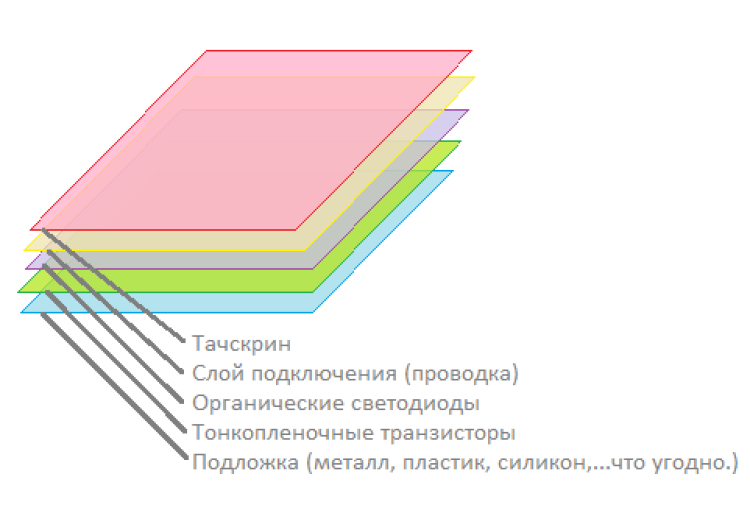
SuperAMOLED displays are brighter than their predecessors, reflect less light and have reduced power consumption. As for energy consumption, due to the fact that the LEDs themselves create light, the energy consumption of the matrix directly depends on the number of working pixels and on the light intensity of the diodes. This is why Samsung uses dark colors in the interface; this has a positive effect on the battery consumption of the diodes.
Results
LCD will soon become an obsolete technology, but the market for mobile devices with these displays will still occupy a significant share. Today, it is the LCD matrix that is most preferable, yes, the gap is already minimal, moreover, the Note 4 display for some may become the best on the market, two or three years - and AMOLED screens will dominate LCD in quality, but AMOLED is not yet enough perfect. On the contrary, LCD is a polished technology that has already achieved almost perfect performance. However, it's up to you to decide anyway.
LCD vs AMOLED. What's better? Vladimir Ukhov
Supporters of technologies used in the manufacture of mobile device displays are divided into AMOLED lovers and LCD supporters. Both types of screens are based on different manufacturing techniques, and manufacturers emphasize the advantages of their own technological process.
So which screen is better - IPS or AMOLED? Is there a noticeable difference between these technologies, and if so, what is it?
LCD technology
LCD stands for LCD display. It reproduces colors completely differently than AMOLED. In a liquid crystal display, the light source is the backlight. The backlight can be multiple, which saves energy, but it is used in large TVs.
White color does not have its own wavelength. It is a mixture of all other visible colors of the spectrum. Thus, the LCD backlight must create virtual white light as efficiently as possible in order to produce different colors in the LCD element. Most LCD displays have a blue LED backlight that hits phosphors and produces near-white light.
The real complications begin when the light is polarized and passed through the crystal. The LCD element can rotate it to different angles by changing the voltage applied to it. Next, the light passes through another one shifted by 90° relative to the first. This dampens it depending on the angle of rotation. The light then passes through the RGB filter, creating subpixels, which are then grouped into pixels.
All this is to say is that the LCD controls the amount of light by blocking the backlight and does not generate colored light for each pixel. Like AMOLED, LCD displays can be either active or passive matrix devices.
AMOLED technology
The key component of screens hidden in the name of this type- light emitting diode (LED). Electronics enthusiasts knew about these bulbs before, but in the display panel they are radically reduced and placed in the form of red, green and blue clusters, which make up a single pixel capable of reproducing white and other colors. The arrangement of these subpixels may have a slight effect on the performance of displays.
The O stands for organic. There are a number of thin organic films placed between the conductors of an LED that emit light when current is applied.
Lastly, the AM part of AMOLED stands for "active matrix" as opposed to passive technology. This indicates how each OLED LED is driven. To control an individual pixel in a passive matrix, controls are used to control the supply of voltage to the required column or row. It's slow and not accurate enough. Active matrix systems in each LED use a TFT transistor and a capacitor. When row and column are activated to access a pixel, its capacitor retains charge between refresh cycles. This allows you to control it quickly and accurately.
Another term that you may come across is Super AMOLED, Samsung's marketing name for a display combined with a capacitive one. Typically, such a screen is made as a separate layer on the outer part of the display. This combination makes the display thinner.

Super AMOLED vs LCD
This profound difference in the way displays operate has a big impact on the user experience. Color gamut is most often mentioned when comparing these technologies. AMOLED provides a greater range of color options than LCD, resulting in brighter images.
OLED displays have extra saturation in green and blue, the most powerful colors in subpixels. Some feel that this extra saturation produces unnatural colors. LCDs tend to overcompensate for red tones with more muted greens. Although they do not have a very wide gamut, the image they produce closely matches the standard color gamut profile used in photos and videos.
A closer look at smartphone displays reveals that color gamut can vary quite significantly even within the same type of display. For example, although the BlackBerry Priv and Galaxy Note 5 use an AMOLED display from the same manufacturer, they have completely different gamma profiles. This can be partially explained by the presence of multiple profiles and different image calibration by the manufacturer.
Color accuracy is another significant difference, especially when it comes to whites. Testing some of best smartphones Android has shown that OLED displays produce very accurate results, while LCD displays have a slight blue tint. This is not surprising given that LCD displays use filtered blue backlighting.
The lack of backlight and filter layers also speaks in favor of OLED. LCDs often leak excess light and have low contrast because the backlight doesn't turn off even when the pixels are supposed to be black, while OLED can simply turn off its pixels. The LCD filter layer also blocks some of the light, and the greater thickness means viewing angles are narrower compared to OLED.
The downside to AMOLED is that different LEDs have different lifespans, meaning that individual RBG components will eventually degrade with at different speeds. The color balance of an OLED display may shift slightly over time, but the LED backlighting of an LCD means the color balance is more stable.
Controllability
One of the main advantages of OLED screens is their high controllability at the level of each pixel. This element can be turned off, allowing you to achieve deep blacks and a high contrast ratio. Controlling radiation at the individual pixel level results in energy savings, and the absence of additional layers above the LEDs means that maximum light reaches the surface. Images become brighter and the viewing angle improves.
Thinness and flexibility
Adherents of AMOLED note the smaller thickness of the screen, which determines the size of the device and its weight. This is due to the lack of backlight. Although this parameter may seem unimportant to many, it has an impact on another important indicator- viewing angle, which directly depends on the thickness of the display.
The use of LEDs means that LED screens are extremely thin, which is ideal for portable devices. The absence of hard backlight and a breakthrough in substrate production made it possible to create the first generation flexible displays, very promising for creating new form factors.
Contrast
One of the main parameters that will help you figure out which screen technology is better - IPS or AMOLED - is contrast. The advantage of LED technology is its huge contrast, which is why users love this technology. When a person sees such a colorful display for the first time, he is very surprised. This is the “wow effect” so revered by marketers.

Black depth
The next parameter that will help you decide which screen is better - IPS or Super AMOLED - is the ability to transmit black color. Due to the fact that LED screens glow on their own, users give them an undeniable advantage. Only the pixels needed in the image are used, and not the entire screen, as in IPS. Contrast is the ratio of the brightness of the lightest and darkest areas of the screen, so the theoretical contrast of organic LEDs is infinite, since there is no glow. But in reality the situation is different; reflected light passes through the black areas. The contrast difference is 20-fold (30,000:1 versus 1,500:1).
Energy consumption
Among the indicators that allow you to decide which is better, IPS or AMOLED, users cite screen efficiency. In LED technology, this is achieved by lighting individual subpixels. The screen spends little energy on dark scenes, but more on light scenes. Therefore, the power consumption of the display depends on the mode of its use.
Performance
Response time also influences consumers' opinions on which display is better - IPS or AMOLED. With the latest technology it is smaller, which in theory should mean a slightly faster picture change. In reality, the longer IPS response time is almost imperceptible. And in Samsung Galaxy S4 another problem appeared - fast image changes cause a noticeable visual effect.
Color rendition
Another question that allows you to choose AMOLED or IPS is which reproduces colors better? IPS displays provide images without distorting the color gamut. The color will be bright when it should be. Natural gamma on LED displays is achieved by customizing the software.
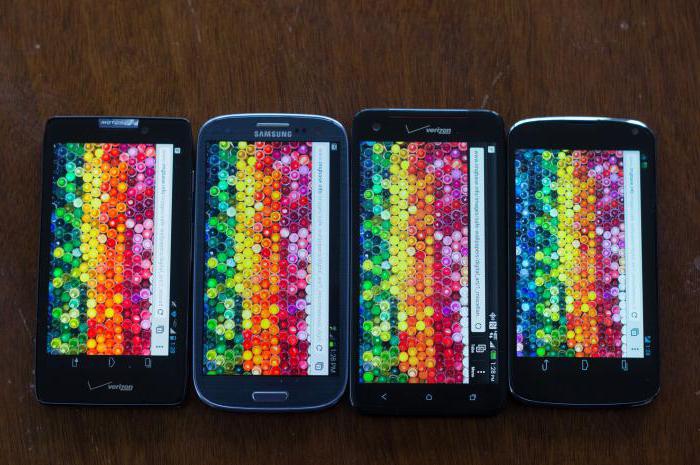
White quality
True white color LED displays, as users say, is difficult to achieve. LCD, on the other hand, produces an imaginary white color emitted by a phosphor. The result is shades of blue, yellow and pink instead of white. In this case, individual image adjustment can help.

Viewing Angles
Another parameter that will help determine which matrix is better - IPS or AMOLED - maintaining color accuracy when viewed at an angle. If we talk about LCD screens, then their colors shift to the cold side, and the non-standard layout of subpixels of LED displays, which is different from the usual one, takes the picture into different colors, for example, it can turn green or red.
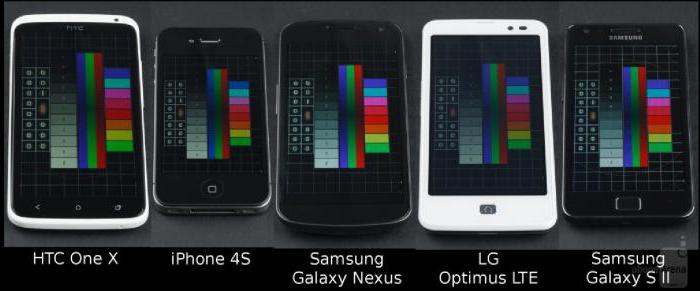
Brightness
High brightness means the image is clearly visible in strong ambient lighting conditions. This is the next parameter that will allow you to decide which is better - IPS or AMOLED. Screen contrast won't help here. In LCD displays, white light is created by a powerful backlight, while LED panels emit every pixel. This explains the difference in light intensity - AMOLED technologies do not yet allow the brightness of subpixels to compete with backlights in LCD displays.
Definition
Which is better - IPS or AMOLED - will help you decide on the detail and sharpness of the image. Some users have no trouble distinguishing the subpixels of an LED screen, which is not good. Myopic people see them clearly even with Full resolution HD. This is explained by the use of PenTile technology, which ensures the same glow of subpixels of different colors. The image loses clarity and has less clear contours. Traditional IPS layout means more detail and straighter lines.

Pixel burn-in
Another “plus” of IPS technology is the “minus” of LED technology. Organic LEDs burn out over time. Although quite large, differences in the brightness of different areas will become noticeable within a year. LCD screens are free from problems with burn-in.
Price
The answer to the question of which is better, IPS or AMOLED, also depends on the price. The cost of the device is determined by the sum of the prices of all its components, the most expensive of which is the display. But a lower price for a gadget does not mean a lower cost for the screen. For example, HTC One with IPS and Samsung Galaxy S4 with Super AMOLED cost the same, although the price is higher.
AMOLED, TFT IPS: which is better?
Technologies have qualities that can be called advantages or disadvantages depending on the user's color and contrast settings. Although the many display modes available in modern smartphones allows you to achieve maximum quality. The lower manufacturing costs and added benefits of OLED displays make them arguably more promising, and lower-cost LCDs are destined to fill gaps in the budget segments of the market.
Leading display manufacturers such as LG Display are betting on OLED technology by investing in additional production capacity. The AMOLED panel market is expected to reach $30 billion in 2022, more than double today's level. Not to mention the yet unrealized potential of the flexible display market.
The development of quantum dot LCDs could close the performance gap between LCD and OLED, so don't count out LCD just yet.
When deciding which type of display to choose - Super AMOLED or IPS, which is better for the user - you should remember: each technology has its pros and cons. Only after weighing all the pros and cons, taking into account the degree of importance of each parameter, does it make sense to make a choice. LCD screens offer slightly more advantages. Among them are natural high-quality color and high image brightness. LED technology is characterized by excessive color saturation, poor readability in bright ambient light, and a shorter service life. Nevertheless, AMOLED displays have an excellent “wow” effect, again and again bringing the next victim to consumer ecstasy.
You can often hear the question, what is the difference between oleophobic displays and liquid crystal displays? They are also AMOLED and IPS. This question is important, since more than 90 percent of the smartphone and tablet market is focused on these two types of displays. So you'll have to answer.
It’s worth starting with the fact that AMOLED can also be Super AMOLED. And IPS can also be referred to as LCD. Both have their advantages and disadvantages. Without delving too far into the technological jungle, we will try to explain in our own words.
It’s worth noting right away that all major manufacturers prefer either one type of display or another. This is due not so much to the price (and IPS is cheaper than AMOLED), but to the technology patents, using which companies pay royalties to the patent holders. Moreover, two seemingly AMOLED smartphones placed side by side can produce pictures of different quality. And this is due to the fact that technologies are patented for slightly different indicators. That is, patent holders are different organizations, in order to avoid monopolies.
When it comes to the difference between AMOLED and IPS LCD in a broad sense, the differences between the two technologies have changed over the years and will continue to change as updates are introduced. So keep an eye out latest updates from large manufacturers.
And now the specifics.
AMOLED
AMOLED technology is an active matrix based on organic light-emitting diodes. Nowadays we often see it in a new look - Super AMOLED. With these displays, individual pixels light up separately. This is called the active matrix. Moreover, they burn on the top of the thin film transistor (TFT). When the entire array passes through an electrical organic compound, it is called OLED. But some companies are cunning and do not pass through the entire array, leaving an unfinished version of the display, which is called TFT. It is cheaper than AMOLED because it has an incomplete cycle. Or, to put it simply, this is half of the whole process. But in any case, a complete or incomplete cycle of this technology shows a better picture than that of IPS LCD. But not in all regions. Assembly is different. So we can only talk about the picture as a whole.

At the heart of its technology, OLED uses anodes and cathodes to flow electrons through a very thin film. The brightness is determined by the strength of the electron current. And color is controlled by tiny red, green and blue LEDs built into the display. The best way to understand the process is to think of each pixel as an independent light bulb with three colors to choose from.
Colors tend to be brighter on AMOLED and Super AMOLED, and black tones appear darker due to part of the screen that can be effectively turned off. When the light bulb is not lit, it produces a “pure” black color. When all three colors are lit, it produces a “pure” white color. So the contrast is better, the colors look brighter, more saturated. Just because each element works separately. Each pixel in this case is an independent nature.
Moreover, it is not said anywhere that the rich colors of the display must destroy the battery charge faster. Battery performance rather depends on the efficient operation of the processor. So AMOLED may be more power hungry than IPS LCD.
Another thing is that AMOLED burns out faster. And this has nothing to do with sun exposure. It’s just that in this case the display works at full capacity, which leads to more intense wear. So pixel quality degrades over time. But they are actively working to solve this problem.
It is also often noticeable that upon closer inspection of a smartphone or tablet based on this technology, the user seems to see all the pixels separately. Only in this case you need to look at the screen at a distance of less than 5 cm, which, of course, spoils your eyesight. So these experiments have no actual application in life. The average user holds a tablet or smartphone about 30 cm from their face.
Samsung is a big fan Super displays AMOLED and actively equips its devices with advanced technologies in this area. This also applies to white balance and sharper black tones. So the latest devices from Korean manufacturer They have a stunningly rich picture and are not afraid of the sun. Wide viewing angle and long time normal operation pixels are included.

The key difference between Super AMOLED and standard AMOLED technology (which is often used by companies trying to save money, like Motorola) is that Super AMOLED has reduced the thickness by an order of magnitude protective film above the sensors, which appears in a more saturated color under the same safety conditions.
In addition, Super AMOLED also offers longer battery life, although again manufacturers work hard to minimize the differences between technologies.
IPS LCD
In the other corner of the ring we have an IPS LCD, which stands for In-Plane Switching Liquid Crystal Display. If Super AMOLED is an upgrade from AMOLED, then IPS LCD is an improvement on the first types of liquid crystal displays. The mighty Apple has become fixated on these types of displays, releasing all iPhones with the same technology over the years. It's cheaper to produce, which is a bonus. But iPhones have never been cheap. So?

Essentially, LCD uses polarized light, which is then passed through a color filter. No separate elements. Horizontal and vertical filters on either side of the liquid crystals control brightness and operate regardless of whether each pixel is on or off. We add backlighting here and we see that usually phones with similar technology have a rather thick body. iPhones from Apple this is rather an exception.
Since all the pixels are backlit, the black balance turns out backlit, “gray”. This is where the contrast suffers. But the white color doesn’t care - it loves many colors, so white looks more beautiful than all other tones on this technology and sometimes even better than an oleophobic display, since there it becomes a little yellowish. The most interesting thing is that Apple calls one of its colors offered for phones dark gray. It's black though. Just overexposed. Because it cannot be otherwise. But against the background of the same color of the case it is not so noticeable. Mimicry tricks the eyes. We think we see black because the brain matches it with the color of the body. A cunning commercial move.
The first thing that's bad about this technology is that the viewing angles are often not very good. This is again the fault of the backlight. Photographers tend to choose IPS LCDs because they display colors more accurately. After all, photographs are often taken in excellent artificial or natural lighting, hence the predominance of white over black. And when we see black and gray night photos, we can blame the bad flash. Only the flash has nothing to do with it. This is the same “dark gray” black color.
Conclusion
![]()
There's no winner when it comes to AMOLED vs IPS LCD, but there are conventions worth considering. Therefore, the quality of the screen primarily comes down to which reference technology the manufacturer uses. It is also worth considering that many color rendering problems - from blurry blacks to white spots - can be removed using digital processing, which is what advanced processors actively do before giving us the final picture. Of course, this affects battery performance. So the company HTC, which relied heavily on digital processing of its advanced cameras by the processor, suffered severe overheating of the chips. Type IPS display played a cruel joke on the Taiwanese manufacturer.
In any case, both technologies have their drawbacks. So it’s nice to have something new, a third, that will bring the advantages of both technologies together to the delight of a satisfied consumer.
I feel that this year AMOLED vs IPS will be a new trend and a topic for endless debate. I want to express my opinion about AMOLED and IPS screens. I won’t go into technical details, just personal impressions.
Since I used the Galaxy S1, Galaxy S2, Galaxy Nexus, a little Note 2, and also Galaxy Tab 7.7, then I understand perfectly what it is AMOLED display and what are its advantages. In turn, I did not ignore displays on IPS matrices: iPhone 4/4S/5, Meizu MX2, HTC Droid DNA (LCD3) and HTC One (IGZO?).
AMOLED vs IPS
IN AMOLED screens often uses its own pixel structure
and most often it's not the best option their layout (PenTile), but in the era of the advent of FullHD resolution in smartphones, you can miss this moment, since it is in AMOLED screens that high pixel density can hide all the jambs with a non-standard subpixel layout.
Active Matrix Organic Light-Emitting Diode (AMOLED) is a technology for creating displays for mobile devices, computer monitors and TVs. The technology involves the use of organic LEDs as light-emitting elements and an active matrix of thin film transistors (TFT) to control the LEDs.
Any display made using AMOLED technology is an advertising bullshield. The colors on such a screen are oversaturated and far from natural, but many people like it, especially at first, until their eyes begin to get tired. To avoid this, Galaxy smartphones have added a special item in the screen settings, in which you can change the color rendering from “tear out your eyes and let them peck a crow” to “dead corpse”. In any mode, the colors are far from natural, I speak as a person who does a little design work.
AMOLED screens are very economical - advertising noodles for your ears. Indeed, when the smartphone screen displays completely black, the power consumption is minimal, but this does not happen so often. Good example is a browser. If the picture is bright, then AMOLED consumes battery power 5-6 times more actively.

If we compare the power consumption of AMOLED screens with IPS, when white color predominates in the picture, then AMOLED begins to consume twice as much charge as IPS. If we consider the option of displaying icons on the desktop when the background is completely black, then the power consumption in both cases is similar. With normal use of smartphone capabilities, the screen on the screen will always be more economical IPS matrix, unless, of course, you put yourself in a box and use black everywhere. For Android there are special versions of gapps, in which standard applications(gmail, contacts, etc.) are inverted to black colors, even the bare Android interface is mostly made in dark colors. Here you may like it as you please, but the advantages in energy consumption of IPS screens are undeniable.
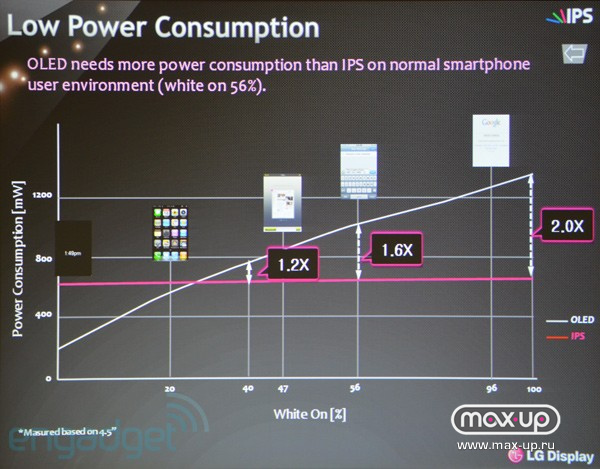
One of the advantages of AMOLED screens is the maximum viewing angles, but here I can argue with fans of these types of screens. If we take into account the IPS smartphone screens that I listed at the beginning of the article, then their viewing angles are maximum, and in the case of the HTC One there is no distortion at all in the color or contrast of the picture. In the case of AMOLED, the contrast and viewing angles are also maximum, but if you look at a light background, then at certain angles it begins to give off different shades (most often green or red).
The undeniable advantage of AMOLED over IPS is true black color, but every year the quality of black color on IPS screens is noticeably improving, and if you look at it from the point of view that everyday use device, we encounter more light shades on the screens than black ones, then the advantage of AMOLED is insignificant.
Update: For non-believers about the burnout effect. Open the instructions for any device with an Amoled screen and read (in in this case sgs3, galaxy note)

Site administrator. Website editor-in-chief
You can debate for a long time which displays are better, AMOLED or IPS, all the same, some will like one type of matrix more, others will like the second. But there is a caveat here: we geeks very often pay attention to such things as the structure of a pixel from subpixels, we measure ourselves against pixels, we look at what is slightly green or blue somewhere... I think ordinary users on many of the technical Not only do they not pay attention to the criteria, they don’t know that such exist! We were wondering, if you show ordinary people (and sometimes even those in the know) two displays “in a vacuum” so that they don’t know which devices these screens belong to, what would they prefer?
What we did: we took two of the coolest displays of one and two types: one in the Samsung Galaxy Tab S 10.5, the second in the iPad Air; packed them tightly in courier envelopes, making small holes for the displays, clearly the same size, so that the difference between the displays was not visible; We loaded the same images onto both models, adapted precisely to the resolution of each model: 2560x1600 pixels, in the case of SGT S, and 2048x1536, and set off to show people the same images on different displays. As you might expect, opinions varied, but the winner in this blind comparison was clear, both indoors and outdoors. You can see the results in the resulting video:
From a geek's point of view, the displays vary, and each is good in its own way.
People like Super AMOLED because it:
- economical when using dark colors on the screen;
- the darkest black color possible;
- high maximum brightness;
- the ability to use only certain pixels, and not the entire screen;
- rich colors;
- maximum viewing angles.
I like IPS because:
- more natural colors;
- true white color;
- greater screen clarity at the same resolution.
Some people don't like Super AMOLED because there are displays that have a distinctly green tint, while most IPS displays look more natural; some AMOLED displays have a pen tile pixel structure, which means that at the same resolution such displays look less clear; On Super AMOLED screens it is very difficult to achieve true white color. But the problem areas of these displays have already been overcome. For example, amoleds stopped giving off the green taste, and when high resolution It is also difficult to distinguish an individual pixel. In our case, the pixel density in Samsung is 287 ppi, and 264 ppi in iPad Air, while the higher density of the Super AMOLED matrix is clearly visible to the naked eye. And the white color in the Tab S is white, not faded green. The examples below clearly show that the viewing angles of our tablets are almost the same, although the IPS matrix darkens at maximum deviations, but the black color of the iPad is not as dark as in Super AMOLED.
